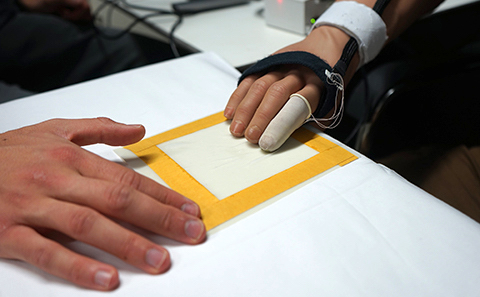Enabling prosthetic limbs to ‘feel’

Technology that enables amputees to ‘feel’ wetness through a prosthesis has been developed by a team of researchers at the University of Southampton and at EPFL, one of the two Swiss Federal Institutes of Technology.
The scientists have developed a sensor that fits on a prosthetic hand and is connected to a stimulator that touches the wearer’s residual limb, so they can feel the sensation of wetness through their skin.
The invention – a world first – could improve the dexterity of prosthetic hands and enhance the sensory experience and acceptance of prosthetic limbs for their users.
Dr Davide Filingeri, Associate Professor in Thermal Physiology and Director of ThermoSenseLab at the University of Southampton, is behind the wetness-sensing aspect of the work. He said: “A lot of work in this field has concentrated on techniques that help restore motor control, but motor control is very difficult without sensation. In the last 10 years, the field of work has tried to restore that sensory feedback.”
Researchers at EPFL, led by Dr Solaiman Shokur and including Maria Ploumitsakou and Jonathan Muheim, developed a sensor that detects temperature via a prosthetic, working with clinical partner Professor Emanuele Gruppioni from the INAIL centre (the National Institute for Insurance Against Accidents at Work) in Italy. Now, Dr Filingeri has worked with them to enable a prosthesis to detect wetness and the level of wetness.

“Through previous work we’ve done at ThermoSenseLab, we know that the way we sense wetness is very much linked to how we sense temperature; we have a specific set of thermal cues that sense wetness,” explained Dr Filingeri.
The developments could have significant physical and psychological benefits for prosthetics wearers.
“We think this is likely to have implications for amputees’ manual dexterity through the prosthetic limb,” said Dr Filingeri. “For example, the level of wetness influences how hard you grab something – if a glass is wet it might be slippery.
“It also expands the range of natural sensations amputees can experience and it enhances the embodiment and acceptance of the prosthetic limb – amputees can feel more like the prosthetic belongs to their body.”
Doctoral Assistant Maria Ploumitsakou, first author on the study, added: “Understanding the human wetness perception with the aim of restoring it in prosthetics users has been a fascinating challenge. Wetness perception is a step towards enriching the way that amputee patients feel and interact with the world.”
The research team is now seeking to prove these implications of their work through determining whether heat and wetness sensing does indeed increase the sense of body ownership for prosthetics wearers.
Dr Filingeri added: “We’ve been working on wetness sensing for the past decade, and it’s wonderful that our fundamental research is being used and translated for clinical impact.”
The research is published online.